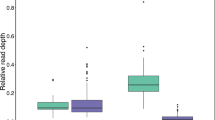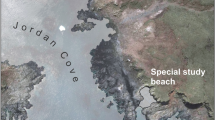Abstract
Histocompatibility—the ability of an organism to distinguish its own cells and tissue from those of another—is a universal phenomenon in the Metazoa. In vertebrates, histocompatibility is a function of the immune system controlled by a highly polymorphic major histocompatibility complex (MHC), which encodes proteins that target foreign molecules for immune cell recognition. The association of the MHC and immune function suggests an evolutionary relationship between metazoan histocompatibility and the origins of vertebrate immunity. However, the MHC of vertebrates is the only functionally characterized histocompatibility system; the mechanisms underlying this process in non-vertebrates are unknown. A primitive chordate, the ascidian Botryllus schlosseri, also undergoes a histocompatibility reaction controlled by a highly polymorphic locus. Here we describe the isolation of a candidate gene encoding an immunoglobulin superfamily member that, by itself, predicts the outcome of histocompatibility reactions. This is the first non-vertebrate histocompatibility gene described, and may provide insights into the evolution of vertebrate adaptive immunity.
This is a preview of subscription content, access via your institution
Access options
Subscribe to this journal
Receive 51 print issues and online access
$199.00 per year
only $3.90 per issue
Buy this article
- Purchase on Springer Link
- Instant access to full article PDF
Prices may be subject to local taxes which are calculated during checkout



Similar content being viewed by others
References
Flajnik, M. F., Miller, K. & Dupasquier, L. in Fundamental Immunology 5th edn (ed. Paul, W. E.) 519–570 (Lippincott, Williams and Wilkins, Philadelphia, 2003)
Dupasquier, L., Zucchetti, I. & De Santis, R. Immunoglobulin superfamily receptors in protochordates: before RAG time. Immunol. Rev. 198, 233–248 (2004)
Oka, H. & Watanabe, H. Problems of colony specificity in compound ascidians. Bull. Mar. Biol. Stn Asamushi 10, 153–155 (1960)
Sabbadin, A. Le basi genetiche dell capacita di fusione fra colonie in Botryllus schlosseri (Ascidiacea). Atti Accad. Naz. Lincei Rend. 32, 1031–1035 (1962)
Scofield, V. L., Schlumpberger, J. M., West, L. A. & Weissman, I. L. Protochordate allorecognition is controlled by an MHC-like gene system. Nature 295, 499–502 (1982)
Boyd, H. C., Brown, S. K., Harp, J. A. & Weissman, I. L. Growth and sexual maturation of laboratory-cultured Monterey Botryllus schlosseri. Biol. Bull. 170, 91–109 (1986)
De Tomaso, A. W., Saito, Y., Ishizuka, K. J., Palmeri, K. J. & Weissman, I. L. Mapping the genome of a model protochordate. I. A low resolution genetic map encompassing the fusion/histocompatibility (Fu/HC) locus of Botryllus schlosseri. Genetics 149, 277–287 (1998)
De Tomaso, A. W. & Weissman, I. L. Initial characterization of a protochordate histocompatibility locus. Immunogenetics 55, 480–490 (2003)
Burge, C. B. & Karlin, S. Finding the genes in genomic DNA. Curr. Opin. Struct. Biol. 8, 346–354 (1998)
Williams, A. F. & Barclay, A. N. The immunoglobulin superfamily—domains for surface recognition. Annu. Rev. Immunol. 6, 381–405 (1988)
Grosberg, R. K. & Hart, M. W. Mate selection and the evolution of highly polymorphic self/non-self recognition genes. Science 289, 2111–2114 (2000)
De Tomaso, A. W. & Weissman, I. L. Evolution of a protochordate allorecognition locus. Science 303, 977 (2004)
Burnet, F. M. Self-recognition in colonial marine forms and flowering plants in relation to the evolution of immunity. Nature 232, 123–126 (1971)
Cannon, J. P., Haire, R. N., Rast, J. P. & Litman, G. W. The phylogenetic origins of the antigen-binding receptors and somatic diversification mechanisms. Immunol. Rev. 200, 200–212 (2004)
Kärre, K., Ljunggren, H. G., Piontek, G. & Kiessling, R. Selective rejection of H–2-deficient lymphoma variants suggests alternative immune defence strategy. Nature 319, 675–678 (1986)
Azumi, K. et al. Genomic analysis of immunity in a basal chordate and evolution of the vertebrate immune system: waiting for Godot. Immunogenetics 55, 570–581 (2003)
Izzard, C. S. Migration of germ cells through successive generations of pallial buds in Botryllus schlosseri. Biol. Bull. 135, 424–431 (1968)
Sabbadin, A. & Zaniolo, G. Sexual differentiation and germ cell transfer in the colonial ascidian Botryllus schlosseri. J. Exp. Zool. 207, 279–301 (1979)
Stoner, D. S., Rinkevich, B. & Weissman, I. L. Heritable germ and somatic cell lineage competitions in chimeric colonial protochordates. Proc. Natl Acad. Sci. USA 96, 9148–9153 (1999)
Buss, L. W. Somatic cell parasitism and the evolution of somatic tissue. Proc. Natl Acad. Sci. USA 79, 5337–5341 (1982)
Buss, L. W. The Evolution of Individuality (Princeton Univ. Press, New Jersey, 1987)
Owen, R. D. Immunologic consequence of vascular anastomoses between twins. Science 210, 400–401 (1945)
Mintz, B. & Russel, E. S. Gene-induced embryological modifications of primordial germ cells in the mouse. J. Exp. Zool. 134, 207–237 (1957)
Carlyle, J. R. et al. Missing self-recognition of Ocil/Clr-b by inhibitory NKR-P1 natural killer cell receptors. Proc. Natl Acad. Sci. USA 101, 3527–3532 (2004)
Iizuka, K., Naidenko, O. V., Plougastel, B. F., Fremont, D. H. & Yokoyama, W. M. Genetically linked C-type lectin-related ligands for the NKRP1 family of natural killer cell receptors. Nature Immunol. 4, 801–807 (2003)
Bottino, C. et al. Identification of PVR (CD155) and Nectin-2 (CD112) as cell surface ligands for the human DNAM-1 (CD226) activating molecule. J. Exp. Med. 198, 557–567 (2003)
Altschul, S. F. et al. Gapped BLAST and PSI-BLAST: a new generation of protein database search programs. Nucleic Acids Res. 25, 3389–3402 (1997)
Tusnády, G. E. & Simon, I. Principles governing amino acid composition of integral membrane proteins: applications to topology prediction. J. Mol. Biol. 283, 489–506 (1998)
Puntervoll, P. et al. ELM server: a new resource for investigating short functional sites in modular eukaryotic proteins. Nucleic Acids Res. 31, 3625–3630 (2003)
Frohman, M. A., Dush, M. K. & Martin, G. R. Rapid production of full-length cDNAs from rare transcripts; amplification using a single gene-specific oligonucleotide primer. Proc. Natl Acad. Sci. USA 85, 8998–9002 (1987)
Pearson, W. R. & Lipman, D. J. Improved tools for biological sequence comparison. Proc. Natl Acad. Sci. USA 85, 2444–2448 (1988)
Davidson, B. & Swalla, B. J. A molecular analysis of ascidian metamorphosis reveals activation of an innate immune response. Development 129, 4739–4751 (2002)
Bassham, S. & Postlethwait, J. Brachyury (T) expression in embryos of a larvacean urochordate, Oikopleura dioica, and the ancestral role of T. Dev. Biol. 220, 322–332 (2000)
Acknowledgements
We thank C. Amemiya, D. Rokhsar, R. Davis, A. Southwick, M. Miranda, D. Ransom, J. Cannon, G. Litman, R. Haire, A. Voskoboynik, J. Wallace and E. Johnson. This study was supported by grants from the National Institutes of Health (a Trans-BAC Sequencing grant) and the Community Sequencing Program at the Department of Energy Joint Genome Institute.
Author information
Authors and Affiliations
Corresponding author
Ethics declarations
Competing interests
Sequence information has been deposited at the NCBI with the accession numbers DQ160291 (for the membrane-bound form) and DQ160292 (for the secreted form). Reprints and permissions information is available at npg.nature.com/reprintsandpermissions. The authors declare no competing financial interests.
Supplementary information
Supplementary Figure 1
Amino acid sequence of the FuHC A allele. (PPT 28 kb)
Supplementary Figure Legend
Text to accompany the above Supplementary Figure. (DOC 20 kb)
Rights and permissions
About this article
Cite this article
De Tomaso, A., Nyholm, S., Palmeri, K. et al. Isolation and characterization of a protochordate histocompatibility locus. Nature 438, 454–459 (2005). https://doi.org/10.1038/nature04150
Received:
Accepted:
Issue Date:
DOI: https://doi.org/10.1038/nature04150
This article is cited by
-
The evolution of extraordinary self-sacrifice
Scientific Reports (2022)
-
The Hydractinia allorecognition system
Immunogenetics (2022)
-
A self-marker-like protein governs hemocyte allorecognition in Halocynthia roretzi
Zoological Letters (2019)
-
High fusibility and chimera prevalence in an invasive colonial ascidian
Scientific Reports (2019)
-
T cell responses to tumor: how dominant assumptions on immune activity led to a neglect of pathological functions, and how evolutionary considerations can help identify testable hypotheses for improving immunotherapy
Cancer Immunology, Immunotherapy (2018)
Comments
By submitting a comment you agree to abide by our Terms and Community Guidelines. If you find something abusive or that does not comply with our terms or guidelines please flag it as inappropriate.



